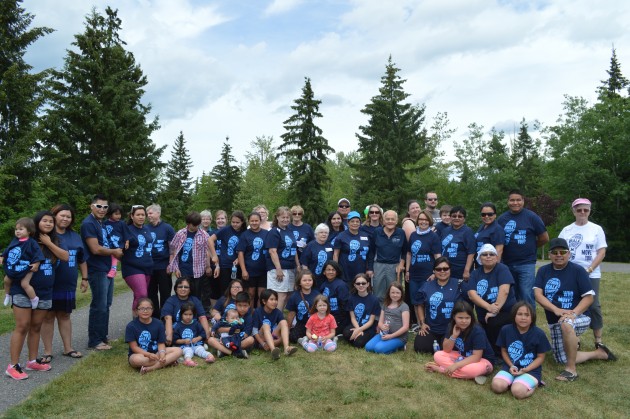Rainbow Park Hosts Walk to Fight Arthritis
Prince George, B.C. – People afflicted with arthritis and their supporters turned out for the 6th annual Walk to Fight Arthritis at Rainbow Park on Sunday.
Local participants were joined by people from Williams Lake and Burns Lake in the effort to raise funds to further research into a disease that, in one form or another, affects people from babies to the elderly. The local event was one of 25 held across Canada on Sunday.
Those taking part were urged to walk a minimum one kilometre however it was pointed out that the idea was to make the walk enjoyable and that participants should only do what they felt comfortable doing. Two routes were available: an Easy Walk along the flat surface of the sidewalk along Rainbow Drive and a Challening Walk incorporating the hilly climbs and descents through the interior of Rainbow Park. The event fee was by donation.
UNBC faculty member Kevin Keen conducted research into arthritic diseases and rheumatic diseases. He has benefitted from the Arthritis Society through contributions to his research through the national agency for work he is doing in spinal arthritis. “I’m a medical statistician and I’m mostly working with the clinical work that’s been collected by physicians and imaging technicians. I’ve been involved in a number of studies, still am involved in a number of studies, everything from looking for bio markers for early disease progression to validating patient-reported outcomes.”
Dr. Keen says “arthritis is an umbrella term and it encompasses osteo-arthritis, which people associate predominantly with a long life and heavy labour, and the rheumatic diseases and that includes rheumatoid arthritis which does affect the internal organs, the lungs, kidneys. Osteo-arthritis is treated by surgeons and family physicians, the rheumatic diseases are treated and managed by rheumatologists who are sub-specialists within internal medicine.”
Dr. Keen says advancements have been made in treating people with arthritis, both surgically and with drugs. He says “osteo-arthritis is typically age-specific because it’s a disease that affects the joints due to use and perhaps overuse. But rheumatoid arthritis, there is a juvenile form that can hit children very early on, typically the onset is before age three. And certainly when they’re able to talk and tell you what’s going on, by age six you know that there’s something going on more than just the usual growing pains.” But he says children very rarely have an osteo-arthritic condition.
With the baby boom generation at retirement age we asked Dr. Keen if we are about to see an explosion of arthritis cases. “As far as joint replacement goes, and for lower mechanical back problems, those are associated with aging and of course there’s the baby boom bubble. And one of the concerns we have as a society is being able to provide services to people with lower back pain and provide for joint replacement. So it’s a major challenge for example for us in British Columbia with the health authorities and being able to provide surgeries for people in a timely manner.”
Dr. Keen says “part of the issue is making sure that we’re doing things efficiently. If you speak to an orthopedic surgeon who specializes in joint replacement, hip and knee, they’ll say, if I was able to get more theatre time I would be able to do more surgeries. So it’s running our system more efficiently and making sure that the waiting times aren’t building up too long. It’s not so much that we’ve got a real problem because we don’t have the medical personnel to take care of the issue it’s running our health care system more efficiently.”
“The other issue is making better use of the allied health professionals like physiotherapists. I mean if you’re going to have a hip replaced there are exercises you can do pre, peri and post-surgery which is going to reduce the demand on the health care system because the recovery time is going to be that much faster.”
And Dr. Keen says “when you’re talking about joint replacement surgery over the last 15 years, things have improved so much that people aren’t as hospitalized as long nor is the recovery period as long.” As an example he says “with hip replacement surgery there the stem that gets inserted into the leg bone. Thirty years ago that stem was smooth metal.”
“What they did to change it was they pock-marked the metal so that the bone could actually graft and grow into it. The next major improvement was using special surgical adhesives so that you don’t have to worry about the joint twisting inside the bone post-surgery because its fixed in the bond by an adhesive that disappears as the bone grafts and grows into the little pockets on the prosthesis.”
He says “if we were still trying to do it the old fashioned way of thirty years ago with the joints they had back then, the backlog would be much worse than it is.”
Dr. Keen says part of the money raised through fundraisers such as the one Sunday “goes to support research, and that includes materials research for artificial joints as well as outreach and communication with patients and their families. It’s an important feature of what the Arthritis Society does.”
By the way the Prince George Walk to Fight Arthritis will be moving from a summertime event to a “Jingle Bell Walk” this November. Local organizers say the summer weekends are now packed with so many events and fundraisers that they’ve decided to make the switch.


Comments
Comments for this article are closed.